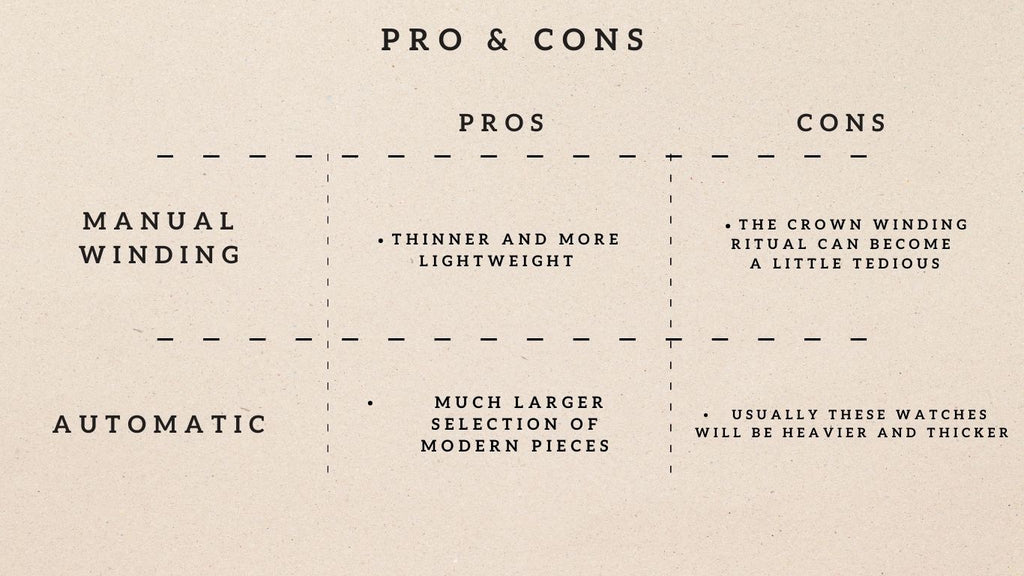How to wind an automatic or hand-wound watch: a guide on how to make your Rolex watch run.
These includes almost all Rolex models, apart from one model called the Oysterquartz which does use a battery as its primary energy source.
However, going back to the majority of Rolex watches that do not require a battery, we can see them divided in 2 big categories: automatic and hand-wound mechanical.
In this article we will explain how to wind an automatic or hand winding watch.
For the automatic watches, the movement — the heart and soul of the watch — is powered by energy generated by your wrist movements as you wear it.
However, for both movements, the secret is in the "crown" as we will see in this article.

How does an automatic watch work?
An automatic movement operates with a rotor that swings back and forth within the timepiece to maintain its functionality. This rotor is activated by the movement of your arm, effectively winding the watch as you wear it.
If the watch remains stationary for an extended period, the automatic movement will cease.
So how do I wind an automatic watch?
An automatic watch functions as its name suggests – it self-winds automatically. However, upon initial wear, manual winding is required to kickstart its internal mechanism.
To do so, follow these steps:
1) Remove the watch from your wrist, as it's best not to attempt winding while wearing it.
2.1) For a traditional automatic watch: Unscrew the crown to position 1. Then gently rotate the crown approximately 30 times clockwise, feeling the resistance.
2.2) For sportive automatic watches that features a screw-down crown for enhanced water resistance: begin by unscrewing the crown three or four times counterclockwise until it pops out. Then proceed to wind the crown around 30 times clockwise to power it.
3) Next, verify the date display. If your watch requires winding and includes a date window, it likely displays an incorrect date. Pull the crown out once from the winding position into Position 2 and rotate it clockwise to adjust the date.
We advise against adjusting the date when the watch hands are near the 12 o'clock position to prevent potential damage to the date mechanism.
4) Adjust the time by pulling the crown out once again into Position 3 and turning it either clockwise or counterclockwise.
5) Ensure the crown is securely screwed back in if you have a screw-down crown. To accomplish this, return the crown to the winding position, push it in once more, and then begin clockwise rotation to secure it in place.
6) You are done!
Try to wear it everyday or put it on a watch winder to avoid to have to repeat these steps.
A hand-wound mechanical watch, meanwhile, requires winding to give the mainspring the energy to keep the gears turning.
So how do I wind an hand winding mechanical watch?
Take off the watch, locate the crown and, while holding it between your thumb and your forefinger, wind it clockwise 20-40 times.
You will feel the resistance and in a manual-wound timepiece you will reach a point where it can no longer be wound.
That's when you are good to go!
If instead you want to modify the date/time of a hand-wound watch, follow these steps:
1) Rotate the crown clockwise. (crown position 0)
2) Adjust the date: rotate the crown counterclockwise. (crown position 1)
3) Adjust the time: rotate the crown cc and clockwise. (crown position 2)
A bit of its story:
In 1931, Rolex invented the Perpetual rotor – the world’s first self-winding mechanism. The term “Perpetual” refers to its ability to run on the energy provided by the motion of the wearer’s wrist.
The rotors or metal weights oscillate freely inside the watch while you wear it. Your hand’s movements spin the rotors which in turn wind the main spring and that’s how the watch is powered automatically.
What are the benefits of mechanical timepieces compared to quartz battery-powered ones?
Mechanical watches are revered for their intricate craftsmanship.
Their movements are crafted with elaborate mechanisms comprising gears, springs, and escapements, showcasing the artistry and precision of fine watchmaking.
This meticulous attention to detail results in the elaborate designs and visually captivating aesthetics of mechanical watches.
Furthermore, the act of winding a watch or experiencing the rhythmic ticking sound evokes a deep appreciation for the history and tradition of watchmaking.
Additionally, mechanical watches are powered by the winding of a mainspring (or, in the case of automatic movements, by the natural motion of the wearer's wrist). As a result, they do not rely on batteries, eliminating the need for frequent battery replacements, which can be more convenient and environmentally friendly.
Mechanical watches are cherished for their craftsmanship, heritage, and sustainability.
